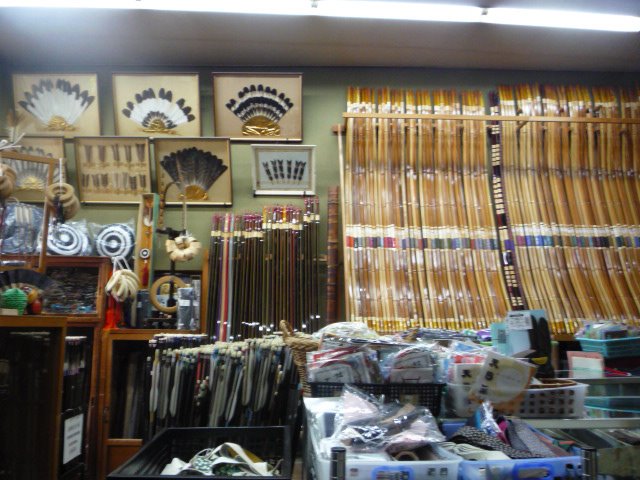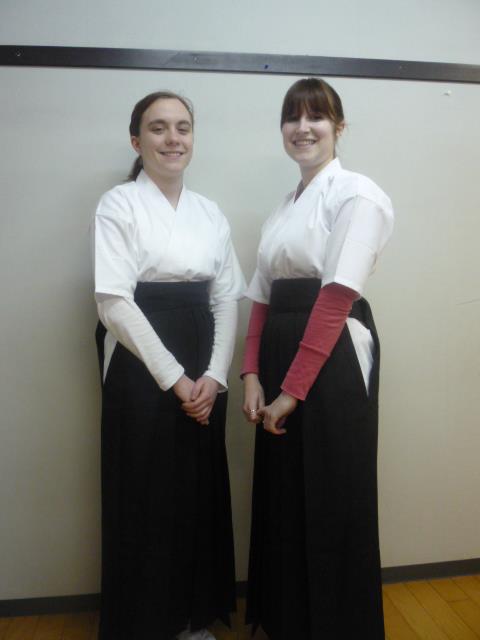To be honest, I wasn’t too confident anyone was actually going to let me choose kyudou for my Community Involvement Project, let alone willingly accept that my three days of attempted archery at Girl Scout camp was more than enough experience to dive right in and mangle my way through this well-respected, traditional Japanese sport. But I wanted to try, and my job was made infinitely simpler because I shared my enthusiasm with two other KCJS students who assured me that I would be a pro before I knew it. Thank god everyone had more confidence in me than I did.
By the first week I had been unsurprisingly labeled “一番弱い学生、” or “Number one weakest student,” by my sprightly seventy-something year-old kyudou teacher. I think we were all a little surprised at how easily we slipped into a rapport with the teachers and our more senior classmates. Apart from the routine greetings, or aisatsu, performed at the beginning and end of practices, there were few cultural hurdles for me to accidentally crash into. On top of that, the teachers kindly teased us as they corrected our form or told us to stop chattering among ourselves (much like our friendly reminders of “日本語だけ” in the Fusokan).
Two and some-odd months later, I am shooting a bow that is as tall as I am into the center of a bale of hay at an alarmingly fast speed. Last practice my senpai and teacher all commented that we had become “上手” – skilled. I take their praise with a grain of salt, because in comparison to my teacher’s over forty-years of training, my measly two seem almost disrespectful. At the same time, the older students (most middle age) are always so helpful, understanding, and truly warm to us that I cannot help but want to try my best and understand as much as I can about kyudou every day I am at practice. Every practice I will inevitably receive an invaluable instruction as to more gracefully lower my bow, or how to tie my obi, or even a piece of chocolate or a cell phone charm. So, perhaps that comment not only applies to kyudou, but also how we have slipped into an easy routine with the dojo and it’s inhabitants. Although I may be living in Japan sans a host family, I feel as though the kyudou dojo has quietly and without much ceremony swept us under its wing.
I may be able to measure some of my growth by how accurately I can shoot an arrow or go through the motions, but kyudou, like many traditional Japanese endeavors, holds itself to a standard closer to artistry than sport. Kyudou is not about hitting the target at the center. Hitting the target at its center is simply the outcome that follows the feeling of shooting your bow with a conviction and accuracy that rings through your very core. It comes up through the bow as the string snaps back, and spreads through your body like a release of adrenaline as you keep your eyes steadily fixed at the target. If you feel that, whether your arrow hits or not is not luck, but inevitability.
My time at the kyudou dojo can’t really be summed up by how well I came to shoot an arrow, or how heavy a bow I can draw, but instead how at home I feel taking my place in the practice hall with these people who so unquestioningly let me give it “the old college try.” In the dojo it doesn’t matter if I am a foreigner or a woman or a college student. I am simply someone who wants to shoot with conviction, and so is everyone else. And on Mondays and Thursdays from four-thirty to five-thirty, I let that feeling ring through me like a bow after the string snaps back into place, and everything is right.



This gave me some great insight into the world of kyudo! Before I had pretty much just seen pictures and occasionally people in real life wearing the uniforms, but I feel like now I understand its similarity to an art form–why it has the same “do” as “sado” or “shodo.” I sort of always wanted to try it but knew I’d be heta. Just out of curiosity, how many people are at this dojo and what’s the average age there? Do younger people mostly join kyudo at their high school/college instead? It’s nice to hear that the sensei took you all under her wing– これからもがんばって!
The average age is around 45 or 50, I think. Some of the assistant women sensei’s are a little younger, 30-35 or so. A few students trickle in now and again, and I think that some of them probably have places to practice at their schools or at another dojo closer to their houses… And don’t worry about the “heta” thing, I thought I would be awful too! (maybe I still am…?)